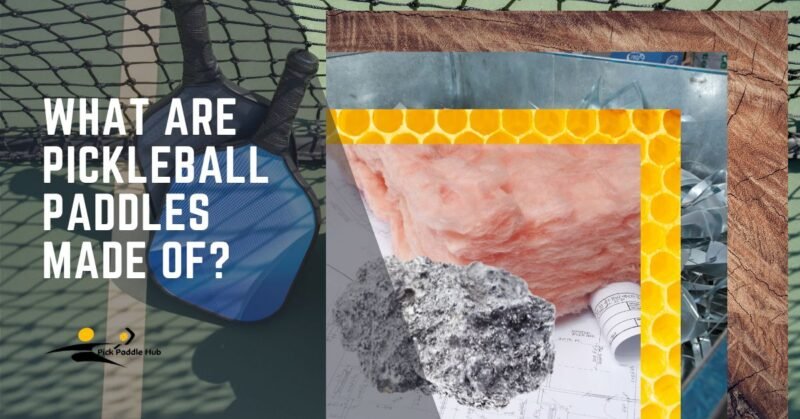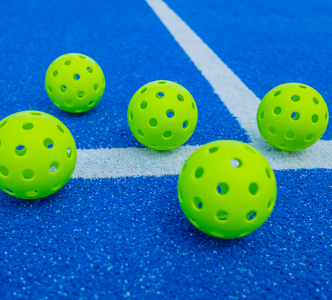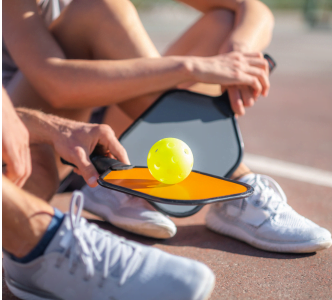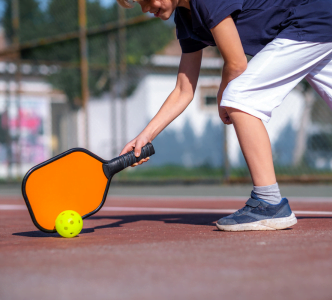Have you ever wondered what makes pickleball paddles so unique and effective? The secret lies in the materials used in paddle construction. Choosing the right pickleball paddle can be a game-changer, but with so many options, it can also be overwhelming.
This guide is here to simplify things for you. We’ll dive into the different pickleball paddle materials, breaking down the materials used in pickleball paddles with pros and cons. Whether you’re a beginner or a seasoned player, understanding these materials will help you make an informed decision, ensuring your paddle complements your game perfectly.
What are Pickleball Paddles Made of?
The information I’m providing about pickleball paddle materials is based on my research and experience as a pickleball player. I suggest that you don’t just rely on this because every player has their own choice, needs, and playing style.
Pickleball paddles are the heart of the game, a crucial tool that connects players to their play. The material a paddle is made from can significantly influence your performance, affecting everything from the speed and accuracy of your shots to how the paddle feels in your hand. It’s not just about having a paddle; it’s about having the right paddle for you.
The most common materials used in pickleball paddles include wood, composite, graphite, and carbon fiber. Each material offers distinct advantages and caters to different styles of play. Wood paddles are often heavier and provide a solid, durable option for beginners or those on a budget.
Composite paddles, made from a blend of materials like fiberglass and polymer, offer a good balance of power and control with a variety of surface textures. Graphite paddles are lightweight and responsive, allowing for quick hand movements and precision shots.
Lastly, carbon fiber paddles stand out for their strength and stiffness, delivering powerful hits with minimal effort.
Understanding the difference between pickleball paddles materials is the first step in choosing a paddle that feels like an extension of your arm. Let’s explore how each material impacts the game, helping you to navigate the choices and find your perfect match.
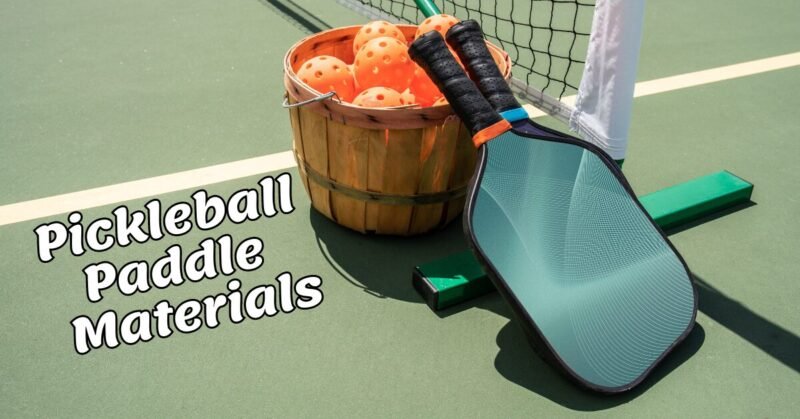
Graphite Pickleball Paddles
Graphite pickleball paddles are a popular choice among players looking for a blend of performance and lightweight design. Made from a thin layer of graphite material over a core (often honeycomb polymer), these paddles are known for their responsiveness and agility on the court.
Characteristics of Graphite Paddles:
- Lightweight: Graphite paddles are among the lightest on the market, reducing player fatigue and allowing for quicker reactions and movements.
- Strength and Durability: Despite their lightweight, graphite paddles are incredibly strong and capable of withstanding intense play without compromising on performance.
- Responsive Surface: The graphite surface offers excellent ball control, allowing for precise shots and the ability to put spin on the ball with ease.
Advantages
- Speed and Control: The lightweight nature of graphite paddles enables players to react quickly, offering excellent control over the ball. This makes them ideal for players who value precision and speed in their game.
- Comfort: With less weight to carry, players can enjoy longer play sessions without feeling fatigued, making graphite paddles a comfortable choice for many.
- Suitable for All Skill Levels: Whether you’re a beginner or an advanced player, the versatility and ease of use of graphite paddles make them suitable for all skill levels.
Disadvantages
- Cost: Graphite paddles tend to be on the pricier side compared to other materials, which might be a consideration for budget-conscious players.
- Less Power: While they offer great control and speed, some players might find graphite paddles to lack the power of heavier options like composite or wood paddles.
Carbon Fiber Paddles
Carbon fiber paddles stand at the pinnacle of pickleball paddle technology, offering a blend of features that cater to both competitive and avid recreational players. Their construction from carbon fiber—a material celebrated for its strength and lightweight properties—sets them apart as high-performance paddles in the world of pickleball.
many players ask the question of what paddle or weight the pro players use, in my opinion, every player should choose the paddle according to their playing style and level of playing pickleball.
Features of Carbon Fiber Paddles
- Lightweight and Strong: Carbon fiber’s most notable attribute is its exceptional strength-to-weight ratio. This allows paddles to be both lightweight for quick, responsive play and durable enough to withstand powerful shots.
- Enhanced Control and Power: The stiffness of carbon fiber translates into better energy transfer from the paddle to the ball, offering players enhanced control over their shots and the ability to generate powerful returns with less effort.
- Vibration Damping: Carbon fiber paddles often feature built-in vibration-damping technologies, which can reduce the shock transmitted to a player’s hand and arm, making for a more comfortable playing experience.
Advantages
- Improved Performance: The combination of lightweight design and strength allows players to react quickly and hit more forcefully, potentially improving their overall game performance.
- Durability: Carbon fiber is known for its durability, making these paddles a long-term investment that can withstand the rigors of frequent play.
- Comfort: The reduced vibration and shock from hitting the ball can decrease the risk of tennis elbow and other play-related injuries, contributing to a more comfortable game, especially during extended play sessions.
Disadvantages
- Cost: The high-quality materials and manufacturing processes used to create carbon fiber paddles are reflected in their price, making them more expensive than other types of paddles.
- Feel: Some players may find the stiffness of carbon fiber paddles to result in a less ‘touch’ feel, which can affect shots requiring finesse and precise control.
- Adaptation Time: Players transitioning from a different type of paddle material may require some time to adapt to the unique feel and performance characteristics of carbon fiber paddles.
Composite Paddles
Composite pickleball paddles are a popular choice among players of all levels, known for their versatility and the wide range of options they offer. These paddles are made from a combination of materials, typically including a blend of fiberglass, carbon fiber, and a polymer core, which allows for a great balance of power, control, and feel.
Features of Composite Pickleball Paddles
- Versatile Performance: Composite paddles strike a balance between power and control, making them suitable for a wide range of playing styles.
- Wide Range of Textures: The surface of composite paddles can be manipulated to include various textures, which can enhance ball spin and control.
- Customization: Due to the variety of materials used, composite paddles can be found in a wide range of weights, shapes, and stiffness, allowing players to find a paddle that closely matches their preferences.
- Durability: The combination of materials used in composite paddles generally offers good durability, standing up well to regular play.
Advantages
- Balanced Play: Composite paddles provide a good mix of power and control, making them a great choice for players who want a balanced paddle.
- Enhanced Spin: The textured surface common to many composite paddles can help players generate more spin on the ball, a key factor for advanced strategies and shots.
- Flexibility in Choices: The wide variety of composite paddles available means that players can select a paddle that fits their specific needs in terms of weight, grip size, and playing style.
- Good Value: Often priced between the higher-end carbon fiber paddles and the more basic wooden options, composite paddles offer a good value for the features and performance they deliver.
Disadvantages
- Jack of All Trades, Master of None: While composite paddles offer a good balance of features, they may not excel in any one area as much as paddles made from specialized materials like pure carbon fiber or graphite.
- Weight Variability: The range in weight can be a disadvantage for players who are sensitive to paddle weight and balance, as it may take time to find the perfect match.
- Wear and Tear: Depending on the quality of the composite materials and construction, some paddles may show wear more quickly than those made from more durable materials like carbon fiber.
Fiberglass Paddles
These paddles have become a staple in the pickleball community, offering players a unique blend of playability and affordability. Made primarily from fiberglass material, these paddles are known for their vibrant designs and excellent performance characteristics.
Characteristics of Fiberglass Paddles
- Responsive Surface: Fiberglass paddles are celebrated for their responsive hitting surface, which provides a good amount of power and pop on contact with the ball.
- Lightweight: While not as light as carbon fiber, these paddles are still relatively lightweight, making them easy to handle and maneuver during play.
- Texture: The surface of this paddle often has a slight texture, which can help players generate spin and control the ball more effectively.
- Aesthetic Appeal: Fiberglass allows for more vibrant and varied designs compared to other materials, making these paddles visually appealing.
Advantages
- Cost-Effective: Fiberglass paddles are generally more affordable than their carbon fiber counterparts, making them a great option for players looking for quality without the high price tag.
- Powerful Shots: The material properties of fiberglass lend themselves to powerful shots, making these paddles a favorite among players who prioritize strength in their game.
- Spin Potential: The textured surface can enhance ball spin, offering an advantage in games where spin plays a crucial role.
- Wide Availability: Due to their popularity, these paddles are widely available in various weights, shapes, and designs, ensuring there’s a paddle for every type of player.
Disadvantages
- Durability Concerns: While durable, fiber-glass paddles may not last as long as those made from carbon fiber, especially with heavy use.
- Heavier than Carbon Fiber: For players who prefer ultra-lightweight paddles for quick hand movements, these paddles might feel slightly heavier in comparison.
- Balance Between Power and Control: While they offer great power, some players might find it challenging to achieve the same level of control as with a graphite or carbon fiber paddle, especially in finesse shots.
Aluminum Pickleball Paddles
Aluminum pickleball paddles offer a distinct playing experience, thanks to their unique core material. These paddles are designed with an aluminum honeycomb core, surrounded by various surface materials, which can include composite or graphite. This construction provides a blend of durability and lightweight performance, making these paddles a choice worth considering for certain players.
Features of Aluminum Paddles
- Lightweight Core: The aluminum honeycomb core contributes to the paddle’s lightweight nature, allowing for quick movements and ease of play.
- Durability: Aluminum cores are known for their durability, making these paddles a long-lasting option for players.
- Sound: Paddles with an aluminum core produce a distinctive sound upon impact, which some players find satisfying.
- Control and Touch: The construction of these paddles often results in excellent control and touch, allowing players to execute precise shots.
Advantages
- Enhanced Control: The aluminum core provides a stable hitting surface that enhances ball control, making these paddles ideal for players who prioritize precision over power.
- Lightweight Feel: Despite their solid construction, these paddles are relatively lightweight, reducing player fatigue and allowing for longer play sessions.
- Durability: The robust nature of the aluminum core means these paddles can withstand significant wear and tear, offering good value over time.
- Affordability: Aluminum paddles are often more affordable than those made with carbon fiber cores, making them a great entry-level option for new players.
Disadvantages
- Power Limitations: While these paddles excel in control and touch, they may not provide as much power as composite or carbon fiber paddles, which could be a drawback for players who rely on forceful shots.
- Temperature Sensitivity: Aluminum can conduct temperature more than other materials, making the paddle feel colder in winter and warmer in summer, which might be uncomfortable for some players.
- Feedback on Impact: Some players may find that aluminum paddles offer less feedback or a ‘dead’ feeling on impact compared to other core materials, which can affect shot precision.
Wood Paddles
Wood paddles hold a special place in the history of pickleball, being the original material used when the game was first invented. Today, they serve as an affordable and durable option for beginners or institutions like schools and community centers. Despite the evolution of paddle materials, wood paddles remain a viable choice for certain players and situations.
Characteristics
- Durability: Wood paddles are known for their robustness. They can withstand rough use, making them ideal for beginners or communal use where paddles might be subject to more wear and tear.
- Weight: Generally, wood paddles are heavier than those made from composite or graphite materials. This can be an advantage or disadvantage, depending on the player’s preference and playing style.
- Simplicity: Wood paddles typically do not have the advanced features found in modern paddles, such as specialized grips or edge guards. Their design is straightforward and functional.
- Affordability: One of the most appealing aspects of wood paddles is their cost. They are among the most affordable options on the market, making pickleball accessible to a wider audience.
Advantages
- Cost-Effective: For players new to pickleball or those looking to equip a group without breaking the bank, wood paddles offer a budget-friendly solution.
- Durability: Their solid construction means wood paddles can take a lot of abuse, which is particularly beneficial for institutional settings where equipment is heavily used.
- Ideal for Beginners: The weight of wooden paddles can help beginners get a feel for the ball, as the mass of the paddle adds power to their shots without the need for perfect technique.
Disadvantages
- Heavier Weight: The added weight of wood paddles can lead to player fatigue more quickly than lighter materials. It can also make quick wrist movements and adjustments more challenging.
- Limited Performance Features: Wood paddles lack the technological advancements of composite or graphite paddles, such as improved control, spin capabilities, and shock absorption.
- Less Comfort: The basic construction of wood paddles often means they’re less comfortable to use over extended periods, especially for players used to the ergonomic grips and designs of modern paddles.
Choosing the Right Material for Your Playing Style
Choosing the right material for your pickleball paddle is crucial for enhancing your playing style and overall game experience. Each material offers a unique set of characteristics, advantages and disadvantages as we learn above. Whether you prioritize power, control, or a balance of both, understanding the nuances of each material can help you make an informed decision that complements your playing style.
Please note that I have tested these paddles and am sharing my own experience with them. Therefore, don’t rely solely on my opinions, as I believe every player has their own expectations and needs. Consider this an informational guide and make your decision based on your own needs and playing style. Before choosing a pickleball paddle make sure to read the USAPA equipment standard.
Graphite Paddles
Ideal for: Players seeking a lightweight paddle for quick, responsive play.
Why Choose Graphite: Graphite paddles are known for their lightweight and stiff nature, offering excellent control and quick hand movements. If your playing style involves precise shots and finesse, a graphite paddle might be the perfect match for you. Its smooth surface also allows for a good feel of the ball, enhancing touch shots and drop shots.
Carbon Fiber Paddles
Ideal for: Competitive players looking for high-performance paddles.
Why Choose Carbon Fiber: Carbon fiber paddles are the top choice for players who demand the best in terms of power and control. They are incredibly lightweight yet strong, allowing for powerful shots without sacrificing speed or accuracy. If you’re an aggressive player who also values precision, carbon fiber offers the best of both worlds.
Composite Paddles
Ideal for: Players who want a balance of power and control with additional spin.
Why Choose Composite: Composite paddles, made from a blend of materials like fiberglass and polymer, offer a great compromise between power and control. They come in various textures, which can help generate more spin on the ball. If you’re a versatile player who enjoys both power plays and strategic shots, composite paddles provide the flexibility you need.
Fiberglass Paddles
Ideal for: Players who prioritize power and spin in their game.
Why Choose Fiberglass: Fiberglass paddles are known for their ability to generate powerful shots with an added spin. The material’s slightly textured surface grips the ball well, making it easier to execute spin shots. If your playing style leans towards aggressive power plays with a touch of spin, fiberglass is an excellent choice.
Aluminum Paddles
Ideal for: Players who value control and precision over raw power.
Why Choose Aluminum: Aluminum core paddles offer great control and a soft touch, making them ideal for players who prefer a strategic game focused on placement and precision. If you enjoy outsmarting your opponent with skillful shots rather than overpowering them, aluminum paddles can enhance your playing style.
Wood Paddles
Ideal for: Beginners and players on a budget.
Why Choose Wood: Wood paddles are the most affordable and durable option, making them suitable for beginners or those who prefer a heavier paddle. While they may not offer the same level of performance as other materials, wood paddles are a great way to get started in pickleball without a significant investment.
Conclusion
understanding the various materials used in pickleball paddles, including graphite, carbon fiber, composite, fiberglass, aluminum, and wood, is crucial for players at all levels. Each material offers distinct advantages and disadvantages, catering to different playing styles, preferences, and needs. Whether you’re a beginner seeking durability and affordability or a competitive player looking for high-performance paddles, your choice should align with your personal playing style and goals. Remember, the journey to finding the perfect pickleball paddle involves considering not just the material but also how it complements your unique approach to the game.
FAQ’s
What is polypropylene in a pickleball paddle?
Polypropylene in a pickleball paddle refers to the type of polymer used in the core of the paddle. It’s a lightweight, durable plastic that offers excellent energy absorption and vibration dampening, enhancing the paddle’s control and feel during play.
What is the difference between carbon fiber and graphite paddles?
The main difference between carbon fiber and graphite paddles lies in their composition and performance. Carbon fiber paddles are known for their strength and lightweight properties, offering high power and durability. Graphite paddles, while also lightweight, prioritize control and responsiveness, with a smooth surface that provides a good feel for the ball.
What is a legal pickleball paddle?
A legal pickleball paddle meets the specifications set by the USA Pickleball Association (USAPA) regarding size, weight, and surface roughness. The paddle must not contain any material that allows a player to impart excessive spin on the ball, and its surface must be smooth, although it can have a textured surface.
Can a player use two paddles in pickleball?
No, a player cannot use two paddles in pickleball during official play. The rules of pickleball specify that a player must use one paddle held in one hand to strike the ball, making the use of two paddles simultaneously against the regulations.
Can a pickleball paddle have a hole in it?
No, a pickleball paddle cannot have a hole in it according to official rules. The paddle’s surface must be solid without any holes, indentations, or rough texturing that could affect the ball’s trajectory. This ensures fairness and consistency in play across all levels of competition.

